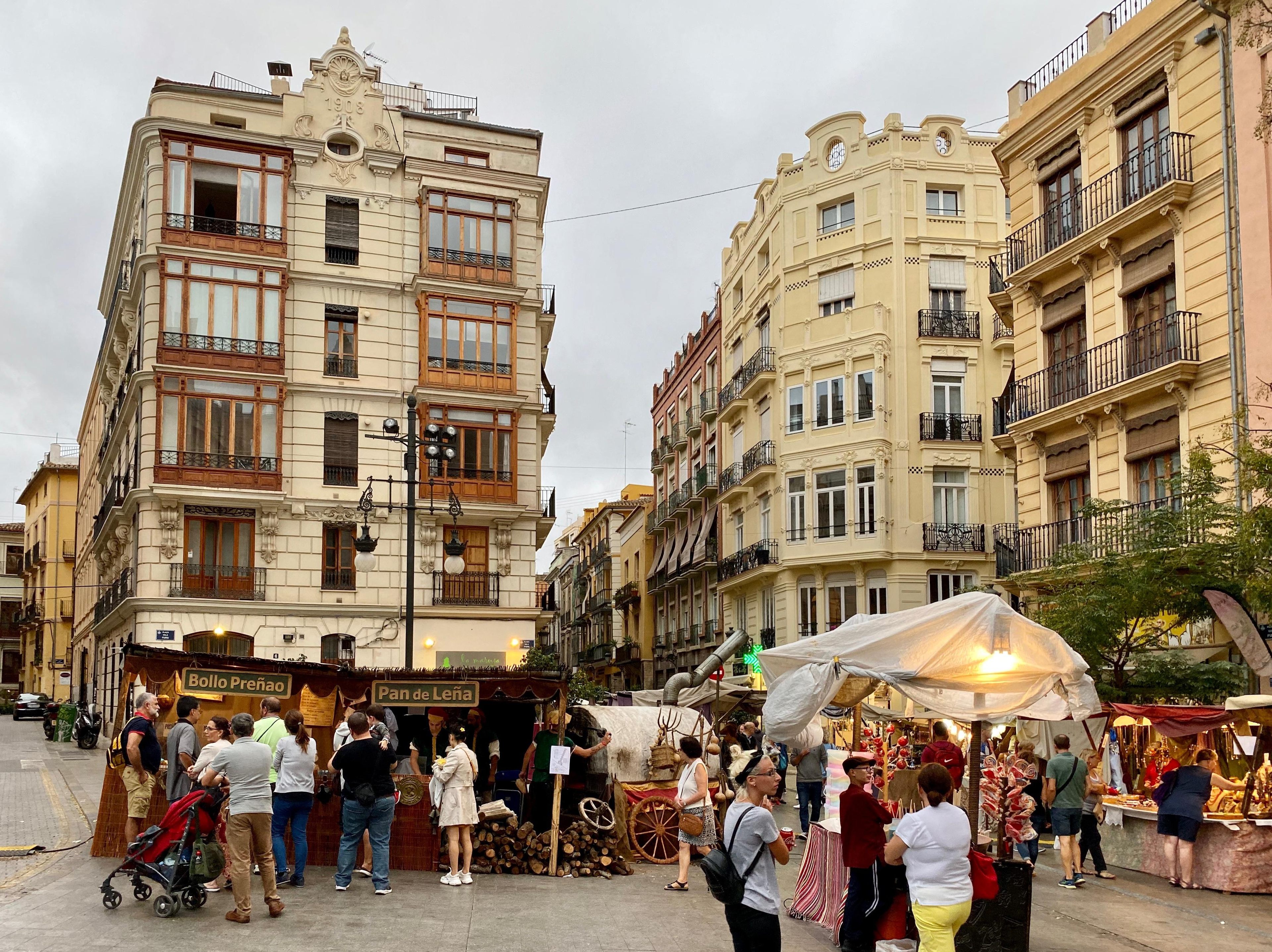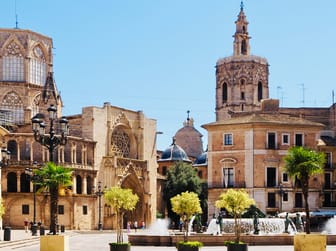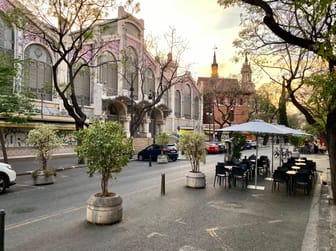EAT + DRINK
SEE + DO
CIUTAT VELLA
Valencians call their historic central district La Ciutat Vella. The Old City, as the 1st district's name translates in Valenciano (the local language similar to Catalan), is comprised of 6 neighborhoods or barrios: El Carme, La Seu, La Xerea, Sant Francesc, El Mercat, and El Pilar.
Map creator: Mike Hall on Behance.com
Always check hours and closure days. Keep in mind that Spanish days start later—many sites don't open until 10 am—but markets open (and close) early. Rearrange to suit individual needs.
Focus on El Carme (aka. El Carmen in Spanish), the most ancient neighborhood of La Ciutat Vella.
El Carme (El Carmen)
Stroll the narrow medieval streets of Barrio del Carmen, the old quarter between the two medieval tower gates where you can still see remnants of the Moorish wall. Visit the museums or walk from plaza to plaza to casually peruse street art. Nightlife here is vibrant among its many restaurants, cafes and tapas bars.
Torres de Serranos
✨ MUST-SEE HIGHLIGHT: Climb the medieval gate towers overlooking Turia Gardens for panoramic rooftop views of the city.
Torres de Serranos
@aligiaudrone
Torres de Serranos makes a great starting point into the old center. The hefty medieval gate towers marked an entry point through the fortified medieval wall that once surrounded the old city at its outermost perimeter.
The original Christian wall was dismantled in 1865 to allow for city expansion and consisted of twelve such gates, one of two still standing (the other is Torres de Quart). A third gate, reduced to a footprint, is Portal dels Jueus or Puerta de los Judeos which can be seen at Plaça dels Pinazos in Sant Francesc (above the Colón metro station).
The view from above is expansive. To the north is Turia Gardens, the outer greenbelt around the city. To the south, Plaça dels Furs provides a marketplace just within the old center. From the opposite side of the plaza, Carrer dels Serrans divides the neighborhoods of El Carmen on the west side and La Seu to the east.

Details
From Plaça dels Furs, turn right down Carrer de Roteros to reach Plaça del Carmen at the Iglesia de la Santa Cruz.
Plaça dels Furs
Parroquia de la Santísima Cruz
@aligiaudrone
Iglesia de la Santa Cruz (Church of the Holy Cross) at Plaça del Carmen was once part of a monastery built in 1281 by the Carmelite monks that gave the neighborhood of El Carme its name. Gothic and Renaissance cloisters and bell tower are its most notable features along with the Baroque Mannerist facade. Next door, the Centre del Carme Cultura Contemporània occupies the remaining part of the old convent.

Details
Continue into the heart of El Carme, known for street art murals in mediums beyond spray can graffiti. Along the way, discover a quirky Valencian cat villa.
House of Cats
@aligiaudrone
On Carrer del Museo, this miniature Valencian-style home is too small for any person to enter but creates a safe haven for feral cats of Valencia who keep rodents at bay.
Next to the cat house, a water line shows the height of the Great Flood of 1957, which ultimately prompted the Turia River drainage and diversion, now Turia Gardens.

Details
Mercat Mossén Sorell
@aligiaudrone
Enjoy fresh oysters or salted cod with a glass of wine or cava in this local market. Built in 1932 on the site of a former Gothic palace that had burned to the ground in 1878, this now luminous boutique market received a facelift in 2008. Shops sell fresh, local produce from L'Horta (La Huerta) and other products from beyond.

Details
The Museum of Modern Art adds visual contrast to the district's antiquity. For cultural and prehistoric enrichment, visit the Prehistory and Ethnology Museums in the Beneficència Cultural Centre.
Institut Valencià d'Art Modern
@aligiaudrone
Enjoy permanent installations of both Spanish and international works from the 20th century onward at IVAM, the modern and contemporary art museum.

Details
Centre Cultural la Beneficència
@aligiaudrone
Museums within the Cultural Center celebrate history and culture. Artifacts in Museu de Prehistòria de València span from the Paleolithic to the Visigoths periods, while the Valencia Ethnology Museum, founded after the fall of Franco's dictatorship, is devoted to reviving regional Valencian heritage previously banned by him.

Details
Reach Torres de Quart, the only other standing gate of the old city at the opposite corner of El Carme. Climb to the top for a different panoramic rooftop perspective of the city.
Torres de Quart

Quart Towers
@aligiaudrone
As a twin to Torres de Serranos where El Carme meets El Pilar, these two hulking towers served as an entrance gate through the fortified Medieval city wall that once surrounded the old city. The original wall, which was dismantled in 1865 to allow for city expansion, consisted of twelve such gates, one of two still standing (the other is Torres de Serranos).
The original Christian wall was dismantled in 1865 to allow for city expansion and consisted of twelve such gates, one of two still standing (the other is Torres de Quart). A third gate, reduced to a footprint, is Portal dels Jueus or Puerta de los Judeos which can be seen at Plaça dels Pinazos in Sant Francesc (above the Colón metro station).
Evident pockmarks remain on its outer western-facing side, impacts of war deliberately left during renovations. 132 cannonball holes and over 1000 rifle shot perforations from Napoleonic French bombardment during the Spanish War of Independence in 1808 show the towers' resistance from siege.

Details
See remnants of the even more ancient Moorish wall, Muralla Árabe, built during Muslim rule (711–1238), at the underground Galeria del Tossal and along Carrer de les Salines where Portal de Valldigna carves an archway through the wall.
Hungry? Several lunch options are near Plaça del Tossal or book a tour with wine and tapas (below).
Galeria and Plaça del Tossal
@aligiaudrone
Restaurants and bars surround Plaça del Tossal. Below, an underground art museum, Galeria del Tossal, displays the Muralla Arabe, the Moorish Wall built in the 11th century under Muslim rule (711-1238).
Though some of the wall is exposed along Carrer de les Salines, much of the wall's remains were enclosed within later medieval buildings, such as with Torre del Ángel, a semicircular tower.

Details
Portal de Valldigna
@aligiaudrone
This ancient archway was built into the original Muslim wall in 1400 to separate the Christian and Moorish Arab areas.

Details
The following Old Town Tour is best booked on Tuesdays or Sundays in order to include San Nicolas (next up in La Seu). After a leisurely 1-hour historic walk, you'll experience (for either lunch or dinner) the best of Valencian produce and cuisine over a 10-course wine and tapas meal in a historic setting.
La Seu
Barrio de La Seu is named for the cathedral that proudly stands among many other impressive churches and plazas. To continue from El Carmen, cross Carrer dels Cavallers to first stop at the Church of Saint Nicholas tucked away on the left.
✨ MUST-SEE HIGHLIGHT: See the impressive Baroque frescos inside San Nicolas.
Parroquia de San Nicolás
@aligiaudrone
This church is tucked away where El Carme meets La Seu. Called Valencia's "Sistine Chapel" for its ornate Baroque frescos that cover nearly every inch of Sant Nicolau de Bari i Sant Pere Màrtir (the Valencian name of this church), it's closed to the public on Mondays. This parish church was among the first of twelve built after the Christian reconquest of Valencia from the Moors by Jaume I of Aragon in 1238.

Details
El Mercat + El Pilar
Since the time of the Moors, El Mercat, the area around the Market has served as a buzzing marketplace and trade center. Today Mercat Central offers fresh goods. Continue westward into the mostly residential neighborhood of El Pilar away from the main monuments of Ciutat Vella.
Sant Francesc + La Xerea
The spacious Sant Francesc neighborhood on the south end of Ciutat Vella, filled with great restaurants and quaint streets, is home to City Hall. La Xerea (pronounced "shayr-AY-uh”) is a livable neighborhood in the eastern corner of Ciutat Vella packed with understated history.
Beyond the Center
Valencia has so much more to explore beyond Ciutat Vella. Be sure to stroll along the greenspace of Turia Gardens that flows through the city. Shop its other markets. Tour its soccer (fútbol) stadiums. Venture over to its Mediterranean beach communities and out to its nature preserves.
FOLLOW ME
* * *


















